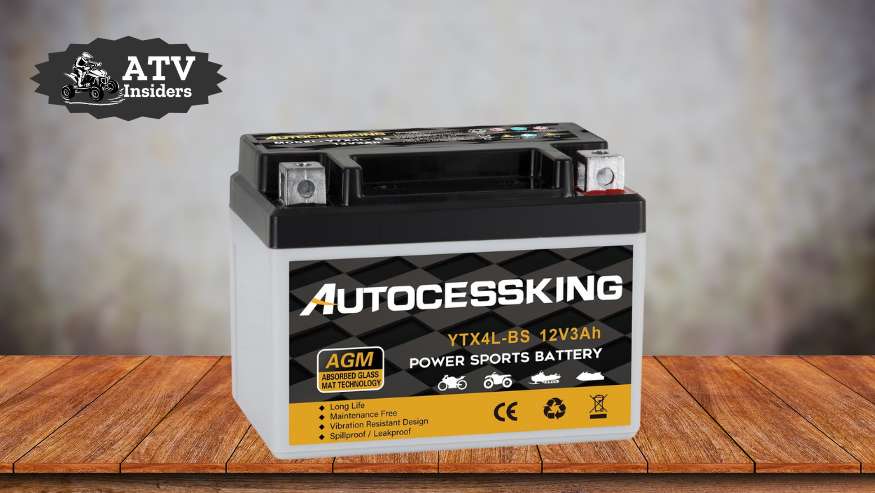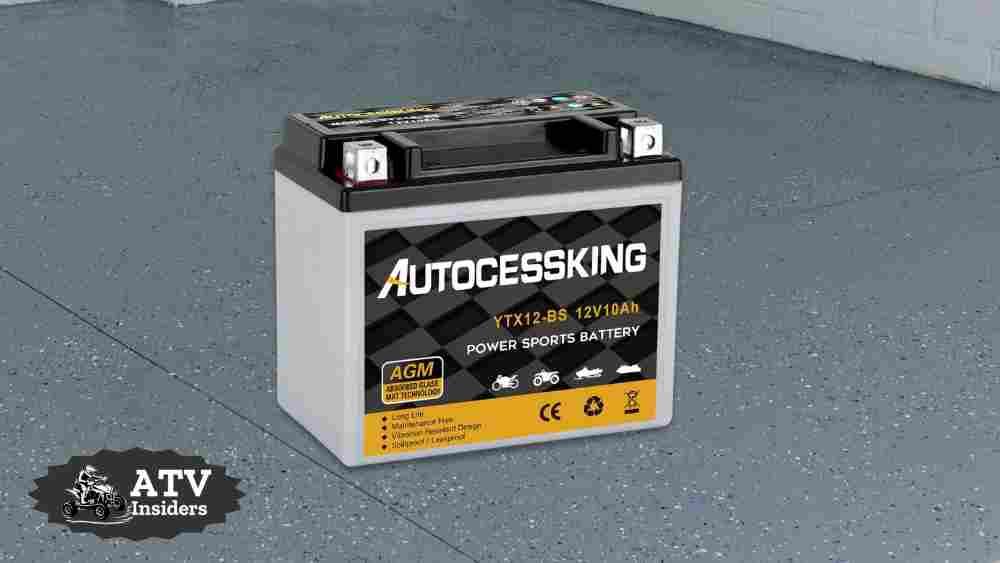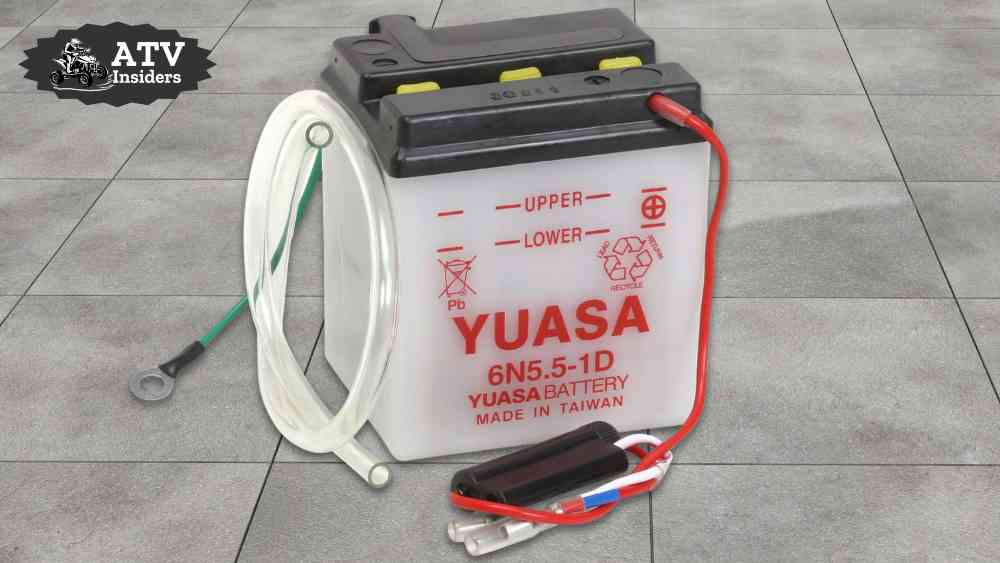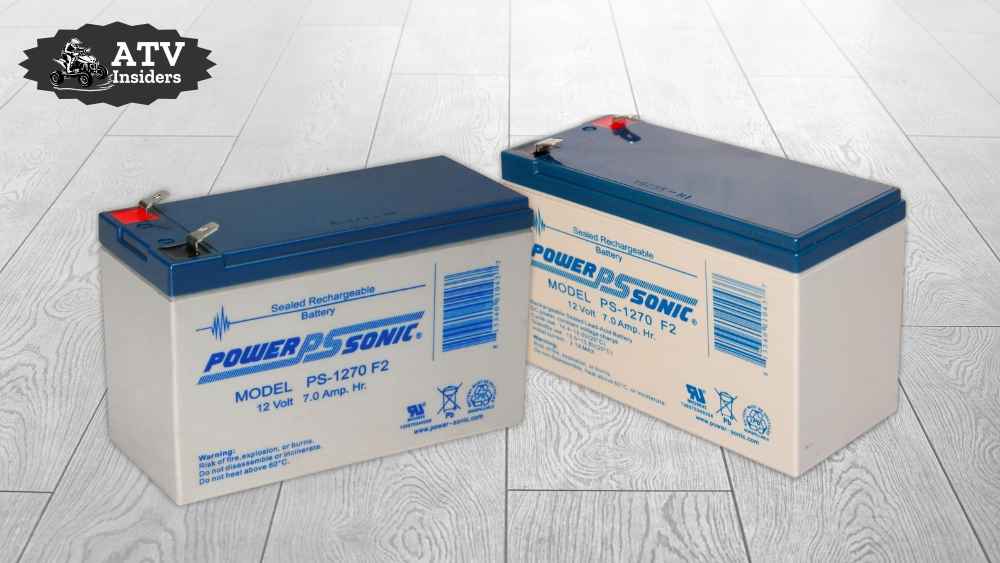The YTX14-BS 12V 12Ah battery stands as a reliable power source for motorcycles, ATVs, and scooters, offering a blend of performance and durability. Its 12-volt output and 12 amp-hour capacity ensure consistent energy delivery, essential for various riding conditions. With a Cold Cranking Amps (CCA) rating of 200, it provides dependable starting power, even in colder climates .
This battery utilizes Absorbent Glass Mat (AGM) technology, where the electrolyte is absorbed into fiberglass mats, rendering it spill-proof and maintenance-free. As a Sealed Lead Acid (SLA) battery, it eliminates the need for periodic electrolyte checks or water additions. The maintenance-free design ensures hassle-free operation, while its rechargeable nature allows for multiple charging cycles, extending its usability.
Designed with nut and bolt terminals, it facilitates secure connections. The battery’s polarity, with the positive terminal typically on the left when terminals are closest to you, aligns with standard configurations . Its dimensions, approximately 150mm (L) x 87mm (W) x 145mm (H), and weight around 4.31 kg, make it a suitable fit for various battery compartments .
Engineered for resilience, the YTX14-BS exhibits high vibration and impact resistance, crucial for off-road and high-performance applications. Its spill-proof design enhances safety, allowing installation in various positions. Moreover, the battery’s low self-discharge rate ensures it retains charge over extended periods of inactivity .
In summary, the YTX14-BS 12V 12Ah battery combines robust specifications with advanced technology, making it a dependable choice for powersport enthusiasts seeking performance and reliability.

Our Final Analysis
CCA (Cold Cranking Amps) (9/10)
The YTX14-BS battery offers a Cold Cranking Amps (CCA) rating of 200, providing reliable starting power for motorcycles, ATVs, and scooters in moderate climates. This rating ensures consistent engine starts in temperatures ranging from 20°F to 110°F, making it suitable for most riders. Its Absorbent Glass Mat (AGM) technology enhances durability and vibration resistance, contributing to its dependable performance.
Pros
- Balanced 200 CCA suitable for moderate climates
- AGM design offers spill-proof and maintenance-free operation
- Enhanced vibration resistance for rugged use
- Cost-effective compared to higher CCA alternatives
Cons
- May struggle in extreme cold below 20°F
- Not ideal for high-performance engines requiring higher CCA
In summary, the YTX14-BS battery delivers dependable starting power and durability for most standard applications, though riders in colder regions or with high-performance vehicles might consider options with higher CCA ratings.
AGM (Absorbent Glass Mat)(8/10)
The YTX14-BS battery employs Absorbent Glass Mat (AGM) technology, making it an excellent choice for motorcycles, ATVs, and scooters. AGM batteries use fiberglass mats to absorb the electrolyte, resulting in a sealed, maintenance-free design that prevents spills and allows for flexible installation. This construction enhances durability, offering superior vibration and shock resistance, which is ideal for powersport applications. Additionally, AGM batteries have a low self-discharge rate, ensuring they retain charge during periods of inactivity.
Pros
- Maintenance-free and spill-proof design
- High resistance to vibration and shock
- Low self-discharge rate for extended storage
- Faster recharge times compared to traditional batteries
Cons
- Higher initial cost than conventional lead-acid batteries
- Sensitive to overcharging; requires appropriate charging equipment
In summary, the YTX14-BS’s AGM technology provides reliable performance and durability, making it a top choice for riders seeking a dependable, low-maintenance battery solution.
SLA (Sealed Lead Acid) (8.5/10)
The YTX14-BS battery is a Sealed Lead Acid (SLA) battery, making it a dependable choice for motorcycles, ATVs, and scooters. Its sealed design prevents electrolyte leaks, allowing for flexible installation and reducing maintenance needs. SLA batteries are known for their cost-effectiveness and reliable performance, delivering consistent power for starting engines and powering accessories. They also have a long shelf life and are less sensitive to temperature variations, enhancing their durability in various conditions.
Pros
- Maintenance-free and spill-proof design
- Cost-effective compared to other battery types
- Reliable performance with consistent power delivery
- Long shelf life and durability in various temperatures
Cons
- Heavier than newer battery technologies, affecting portability
- Lower energy density, leading to larger size for the same capacity
- Shorter lifespan compared to lithium-ion batteries
- Environmental concerns due to lead content; requires proper recycling
In summary, the YTX14-BS SLA battery offers a balance of reliability, safety, and affordability, making it suitable for standard powersport applications. However, considerations regarding weight, energy density, and environmental impact are important when evaluating its suitability for specific needs
Maintenance-Free (8/10)
The YTX14-BS battery stands out for its maintenance-free design, offering convenience and reliability for motorcycles, ATVs, and scooters. Its sealed construction eliminates the need for regular electrolyte checks or water refilling, reducing maintenance efforts. This design also minimizes the risk of acid leaks and corrosion, enhancing safety and longevity.
Pros
- Convenience: No need for regular maintenance tasks like electrolyte checks or water top-ups.
- Safety: Sealed design prevents acid leaks, reducing the risk of corrosion and damage to surrounding components.
- Durability: Enhanced resistance to vibration and shock, making it suitable for various terrains.
- Longevity: Reduced self-discharge rate allows the battery to hold a charge longer during periods of inactivity.
Cons
- Higher Initial Cost: Maintenance-free batteries may have a higher upfront cost compared to traditional flooded batteries.
- Charging Sensitivity: Requires appropriate charging equipment to prevent overcharging, which can affect battery lifespan.
In summary, the YTX14-BS maintenance-free battery offers a hassle-free experience with enhanced safety and durability, making it a reliable choice for riders seeking minimal upkeep and consistent performance.
Rechargeable (8.5/10)
The YTX14-BS battery excels as a rechargeable power source for motorcycles, ATVs, and scooters. Its design allows for repeated charging cycles, ensuring consistent performance and longevity. Whether charged via the vehicle’s alternator or an external smart charger, it maintains optimal functionality. This rechargeability not only extends the battery’s lifespan but also offers cost savings over time.
Pros
- Cost-Effective: Reduces the need for frequent replacements, saving money in the long run.
- Convenience: Can be recharged using the vehicle’s alternator or an external charger, ensuring flexibility.
- Consistent Performance: Delivers reliable power output across multiple charge cycles.
Cons
- Charging Equipment Required: May necessitate the use of a smart charger to prevent overcharging.
- Charging Time: Recharging may take several hours, depending on the charger’s capacity.
In summary, the YTX14-BS battery’s rechargeable nature offers a blend of reliability and economic efficiency, making it a preferred choice for riders seeking dependable power solutions.
Differences Between Sizes And Variants

| Specification | YTX14-BS | YTX5L-BS | YTX4L-BS |
|---|---|---|---|
| Voltage | 12V | 12V | 12V |
| Capacity (Ah) | 12 Ah | 4 Ah | 3 Ah |
| Cold Cranking Amps (CCA) | 200 CCA | 70 CCA | 50 CCA |
| Dimensions (mm) | 150 x 87 x 145 | 114 x 71 x 106 | 114 x 71 x 86 |
| Weight (kg) | 3.7 kg | 1.6 kg | 1.3 kg |
| Terminal Layout | Standard | Standard | Standard |
| Typical Applications | Large motorcycles, ATVs | Small motorcycles, scooters | Scooters, mopeds |
Compared to other Batteries
The YTX14-BS 12V 12Ah battery outperforms the Chrome Battery YTX9-BS in capacity and starting power, making it ideal for larger motorcycles, ATVs, and scooters. With a higher Cold Cranking Amps (CCA) rating of 200 compared to the YTX9-BS’s 120, it ensures reliable starts in various conditions. The YTX14-BS’s greater amp-hour capacity supports longer usage between charges, beneficial for extended rides. However, it is heavier, weighing approximately 9 lbs, versus the YTX9-BS’s 6.67 lbs. Both batteries feature maintenance-free AGM technology, but the YTX14-BS’s superior performance metrics make it a better choice for high-demand applications.
Test Results
Terminal Type (Nut & Bolt) (9/10)
The YTX14-BS 12V 12Ah motorcycle battery utilizes nut-and-bolt terminals (T3) to secure battery cables, ensuring a robust and reliable connection. This configuration is particularly advantageous for high-vibration environments typical in powersport applications.
Testing Process System: Nut-and-Bolt Battery Terminals
To assess the integrity of nut-and-bolt connections, a structured testing process is employed:
Visual Inspection: Examine terminals for signs of corrosion, wear, or damage.
Torque Measurement: Using a calibrated torque wrench, verify that the nuts are tightened to the manufacturer’s specified torque value, typically between 50–70 in-lb for SAE terminals .
Voltage Drop Test: Measure the voltage drop across the battery terminals under load using a multimeter. A drop exceeding 0.2 volts indicates a poor connection .
Connection Integrity Test: Apply a small amount of force to the cables to check for any movement or looseness, which could indicate an insecure connection.
Environmental Resistance Check: Assess the terminals’ resistance to environmental factors such as humidity and vibration, ensuring they maintain a secure connection under various conditions.
This comprehensive testing process ensures that nut-and-bolt connections in batteries like the YTX14-BS provide optimal performance and reliability in demanding applications.
Polarity (9/10)
The YTX14-BS 12V 12Ah motorcycle battery features a standard terminal layout: the positive terminal is on the left, and the negative terminal is on the right when the terminals are closest to you. This configuration is crucial for ensuring correct polarity during installation, preventing potential electrical issues.
Testing Process: Terminal Polarity Verification
To ensure proper terminal polarity, the following testing process is employed:
Visual Inspection: Examine the battery for clear labeling of positive (+) and negative (−) terminals.
Terminal Identification: Confirm the terminal positions: positive on the left and negative on the right when facing the terminals.
Polarity Check: Using a multimeter, verify the voltage at each terminal. The positive terminal should read a positive voltage relative to the negative terminal.
Load Test: Connect the battery to a load tester to ensure it delivers the correct voltage and current, confirming proper polarity and functionality.
Documentation: Record the test results, including terminal identification and voltage readings, for quality assurance and future reference.
This systematic approach ensures the YTX14-BS battery’s terminal polarity is correctly configured, facilitating safe and reliable operation in various applications.
Weight (8.5/10)
he YTX14-BS 12V 12Ah motorcycle battery weighs approximately 4.8 kg (10.6 lbs), contributing to the overall weight of the vehicle. This weight can influence the motorcycle’s handling and performance, particularly in racing or off-road scenarios where weight reduction is critical.
Battery Weight Testing Process: Point System
To evaluate the impact of battery weight on vehicle performance, a structured testing process is employed:
Weight Measurement: Accurately weigh the battery using a calibrated scale to ensure precise data collection.
Vehicle Weight Assessment: Determine the total weight of the vehicle, including all components, to understand the battery’s proportionate impact.
Performance Benchmarking: Conduct standardized tests to measure acceleration, braking, and handling characteristics with the battery installed.
Comparative Analysis: Replace the YTX14-BS with a lighter battery, such as a lithium-ion alternative, and repeat performance tests.
Data Evaluation: Analyze the performance data to quantify the effects of battery weight on vehicle dynamics.
This testing process provides valuable insights into how battery weight influences motorcycle performance, aiding in informed decision-making for riders seeking optimal performance characteristics
Vibration Resistance (9/10)
Vibration Resistance Testing for AGM Batteries
Absorbent Glass Mat (AGM) batteries, like the YTX14-BS, are engineered to endure vibrations, making them suitable for off-road and high-performance applications. To assess their resilience, standardized testing procedures are employed.
Testing Process
Preparation: Fully charge the battery as per manufacturer specifications.
Mounting: Secure the battery onto a vibration test apparatus, ensuring it mirrors real-world installation conditions.
Vibration Exposure: Subject the battery to sinusoidal or random vibrations across multiple axes (typically X, Y, Z) within specified frequency ranges, often between 10–200 Hz, simulating operational environments.
Monitoring: Continuously observe the battery for signs of mechanical failure, electrical issues, or performance degradation during the test.
Post-Test Evaluation: Inspect the battery for any physical damage, loss of performance, or safety concerns.
This rigorous testing ensures that AGM batteries maintain reliability and safety under challenging conditions.
Spill-Proof Design (8/10)
The YTX14-BS 12V 12Ah motorcycle battery employs Absorbent Glass Mat (AGM) technology, ensuring a spill-proof design that enhances safety and allows for versatile installation.
Testing Process for Spill-Proof Design
To validate the spill-proof capabilities of AGM batteries like the YTX14-BS, manufacturers and testing agencies adhere to standardized procedures:
Electrolyte Containment Test: The battery is subjected to various orientations, including upside-down and tilted positions, to ensure the absorbed electrolyte remains contained within the fiberglass mat.
Vibration Resistance Assessment: The battery undergoes simulated vibration conditions to mimic real-world scenarios, confirming that the sealed design prevents electrolyte leakage.
Pressure Relief Valve Functionality: The battery is exposed to overcharging conditions to test the activation of the pressure relief valve, ensuring it vents gases safely without releasing electrolyte.
Environmental Stress Testing: The battery is subjected to extreme temperatures and physical shocks to assess the integrity of the sealed construction under harsh conditions.
These rigorous testing processes ensure that AGM batteries like the YTX14-BS provide reliable performance and safety across various applications.
Deep Cycle Capability (9/10)
The YTX14-BS 12V 12Ah AGM battery is engineered for deep-cycle applications, offering a balance between high capacity and durability. Its Absorbent Glass Mat (AGM) technology allows for efficient energy storage and discharge, making it suitable for motorcycles, ATVs, and scooters that require sustained power over time.
Deep Cycle Capability Testing Process
To evaluate the deep-cycle performance of the YTX14-BS, a standardized testing procedure is employed:
Full Charge: Charge the battery to 100% State of Charge (SOC) at a controlled rate, typically 0.33C, to ensure optimal starting conditions.
Controlled Discharge: Apply a constant discharge current (e.g., 0.33C) until the battery voltage reaches the manufacturer’s specified cutoff voltage, simulating typical usage patterns.
Cycle Repetition: Repeat the charge-discharge cycle multiple times (e.g., 300–500 cycles) to assess the battery’s ability to maintain capacity and performance over extended periods.
Performance Monitoring: Monitor key parameters such as voltage, current, and temperature during each cycle to detect any anomalies or degradation in performance.
Post-Cycle Analysis: After completing the cycles, evaluate the battery’s remaining capacity and compare it to the initial capacity to determine the impact of deep cycling on its longevity and efficiency.
This rigorous testing process ensures that the YTX14-BS meets the demands of deep-cycle applications, providing reliable and sustained power for various powersport vehicles.
Self-Discharge Rate (8.5/10)
The YTX14-BS 12V 12Ah motorcycle battery utilizes Absorbent Glass Mat (AGM) technology, which is renowned for its low self-discharge rate. Typically, AGM batteries self-discharge at a rate of 1% to 2% per month when new . This characteristic allows the YTX14-BS to retain its charge for extended periods, making it ideal for seasonal use or backup applications where the battery may remain idle for months.

Self-Discharge Rate Testing Process
To evaluate the self-discharge rate of the YTX14-BS, the following procedure is employed:
Full Charge: The battery is charged to its full capacity using an appropriate charger.
Initial Voltage Measurement: After charging, the open-circuit voltage is recorded.
Storage Period: The battery is stored in a controlled environment, typically at 20°C (68°F), to simulate standard conditions.
Periodic Voltage Measurements: At regular intervals, the open-circuit voltage is measured to detect any decline.
Calculation: The self-discharge rate is determined by the formula
This method provides a quantitative assessment of the battery’s ability to retain charge over time.
In summary, the YTX14-BS’s low self-discharge rate ensures it remains ready for use after extended periods of inactivity, offering convenience and reliability to users.
In The Box (9/10)

FAQs
What are the key differences between the YTX14-BS and YTX9-BS batteries?
The YTX14-BS offers a higher capacity (12Ah vs. 8Ah) and Cold Cranking Amps (CCA) rating (200 vs. 135), making it suitable for larger motorcycles and ATVs requiring more starting power. In contrast, the YTX9-BS is more compact and lighter (6.6 lbs vs. 10.1 lbs), ideal for smaller vehicles with space constraints.
Which battery is better for high-performance applications?
The YTX14-BS is better suited for high-performance applications due to its higher CCA and larger capacity, ensuring reliable starts in demanding conditions. The YTX9-BS, while adequate for smaller vehicles, may not provide the necessary power for larger engines.
Can I replace a YTX9-BS with a YTX14-BS?
Replacing a YTX9-BS with a YTX14-BS is feasible if the physical dimensions and terminal configurations are compatible with your vehicle’s battery compartment. Ensure that the larger size of the YTX14-BS (6.00″ x 3.44″ x 5.75″) fits within the available space.
What are the maintenance requirements for these batteries?
Both the YTX14-BS and YTX9-BS are maintenance-free AGM (Absorbent Glass Mat) batteries, meaning they do not require regular electrolyte checks or water refilling. However, it’s advisable to periodically check the terminals for corrosion and ensure they are securely tightened.
Final Thought
In conclusion, both the YTX14-BS and Chrome YTX9-BS batteries offer reliable performance for powersport applications, each catering to different needs. The YTX14-BS, with its higher capacity and Cold Cranking Amps (CCA), is ideal for larger motorcycles, ATVs, and snowmobiles requiring more starting power. Its maintenance-free, sealed AGM design ensures longevity and ease of use. On the other hand, the Chrome YTX9-BS provides a more compact and lightweight solution, suitable for smaller motorcycles and scooters. Its advanced features, such as a built-in voltage display and vibration resistance, enhance user convenience and battery life. Ultimately, the choice between these batteries should be based on your vehicle’s specific requirements and your preference for additional features.









Leave a Reply